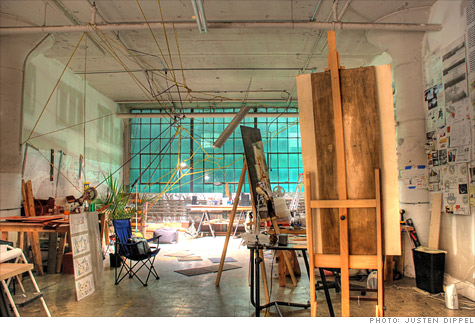Detroit's new factory of dreams
 An architect's studio at Detroit's Russell Industrial Center, home to 160 small businesses.
An architect's studio at Detroit's Russell Industrial Center, home to 160 small businesses.
FORTUNE -- This is a story of two Detroit factories, one a symbol of despair and the other of promise. On the one hand is the old Packard car plant on East Grand -- 3.5 million square feet on 38 desolate acres. Broken windows, crumbling bricks, creeping vines, and a FOR SALE sign that's been hanging there for years. "Most of the interest," realtor David Wax told us, "is to tear it down for the steel in the building."
On the other hand, just down the road, stands an icon of hope, a gargantuan factory complex, the Russell Industrial Center. It has the same lofty pedigree as the Packard plant (both were designed by Albert Kahn) and a similar vintage (it was built in the 1920s). As the former headquarters of Murray Corp., which made bodies for Ford in the glory days, this plant, too, is inhabited by ghosts. Here, however, the ghosts share quarters with some spirited company: a menagerie of glass blowers, cabinetmakers, architects, seamstresses, a sneaker designer, and three women who teach pole dancing, among others -- 160 small-business tenants in all, most of them operating on the frontlines of Detroit's burgeoning creative economy.
Their landlord is Dennis Kefallinos, 55, who immigrated from the Greek island of Zakynthos when he was 15, found a job as a dishwasher, and in all these years has never once stopped working long enough to learn how to read and write properly. Today, while he's best known around town as the owner of Niki's Pizza and a place called Bouzouki (which is, gulp, a strip club), he's one of the city's biggest real estate barons.
Kefallinos began buying "distressed properties, big structures," in the '90s, he says, thinking that "in 20 years Detroit is gonna be so hot. Isn't that crazy?" He bought the Russell Center in 2003 for $1.5 million. A bargain, except that most of its 2.2 million square feet were vacant, many of its windows had been blown out by a tornado, and it was losing $50,000 a month. Chris Mihailovich, the property manager, says he really didn't know what to do with the place. Until the artists started calling.
"At first we kind of laughed it off," Mihailovich says. But with nothing to lose, they chose one empty floor, framed in a row of 1,000-square-foot studios, which they offered at around $550 a month, heat included. "And guess what? We filled it. And we made another one, and another one."
The Russell Center is not Kefallinos's most profitable property. To be honest, he's not completely sold on the whole artist-community thing; he's still looking for "the guy who will take 100,000 square feet by the railroad tracks." Meanwhile the creative types keep coming, an average of one new tenant a week.
Whatever's happening here -- without any help, by the way, from government or philanthropies -- it's organic, it's mutually supportive, and it's uniquely Detroit. Terri McQueen worked for nine years at Chrysler's Detroit Axle plant until she got "really, really sick" one day, she says, and they sent her home. She never went back. This April, after 18 months of planning, she opened Ya Digg Records, a vinyl-LP merchant, at the Russell Center. Lisa Caston, whose studio is upstairs, is co-owner with her sister, Deborah Edgar, of the Detroit Sewing Spot. Caston likes to forage in a nearby abandoned Cadillac factory for pieces of rusty machinery, which she uses to transfer Industrial Age patterns to fabric. Another Russell tenant, designer Christian Unverzagt, routinely draws on offshoot technologies from the auto industry -- such as laser-cut stainless steel -- to execute his visions.
Sarah Lapinski, one of the youngest entrepreneurs at the Russell Center, grew up in the Detroit suburbs. She was an urban studies major at Wayne State, where she used to dream about moving someplace more livable, like Portland, Ore. But after college Lapinski took a sudden turn -- "I started sewing, maniacally," she says. Today she has her own clothing line, Wound Menswear, and her own business, Motor City Sewing, and owns a home in southwest Detroit, hard by the first drive-in theater in America.
"Now I'm watching all my friends I grew up with, went to school with, partied with," Lapinski says. "They're all starting little businesses too. It's always been a small town for me, with big-city amenities. I love the urban farming movement. Go ahead, industry, keep moving out! We're cleaning up the air, we're cleaning up the water -- it's kinda cool."
For the record, at least 25,000 wage earners jammed into the old Packard plant at its peak, and that was just one factory. The Russell Center, even now, is 75% vacant. This may take some time. ![]()








